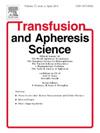The RhCcEe phenotype incompatibility in Chinese and presence of DEL in serologically D–, C/E+ individuals
IF 1.2
4区 医学
Q4 HEMATOLOGY
引用次数: 0
Abstract
Background
Red cell antibodies of a certain specificity are produced following the immunization of a corresponding antigen-negative individual through pregnancy or transfusion, such as RhCcEe allogeneic infusion. The transfusion incompatibility of RhC/c and RhE/e can be estimated based on the proportion of the RhCcEe phenotype. DEL has been positively correlated with RhC and RhE phenotypes. Elucidating the RhCcEe phenotype may facilitate the identification and screening of DEL variants.
Objective and methods
The risk of alloimmunization due to RhC/c and RhE/e incompatibility were estimated by analyzing the frequency of RhCcEe phenotypes in 783 RhD negative blood donors and more than 458,000 RhD positive individuals. DEL screening was performed on RhC+ and/or RhE+ samples from RhD negative population. A total of 106 RhC+ and(or) RhE+ RhD negative blood donors were selected for DEL screening using an absorption and elution test, fluorescent probe-based quantitative PCR, and RHD sequencing.
Results
Significant differences in RhCcEe phenotype distribution were observed between RhD positive and RhD negative Chinese individuals. Among RhD-positive Chinese individuals, the transfusion incompatibility rates for E/e and C/c were notably high at 31.09 % and 34.04 %, respectively. The highest alloimmunization risks were observed for anti-c (24.889 %), followed by anti-E (24.731 %). The RhD negative population had the highest alloimmunization risk of anti-C(24.257 %). Among the 106 RhC+ and(or) RhE+ D-negative samples, thirty-four DELs were observed, with a proportion of 16.27 %. Thirty-two DELs were confirmed to have the RHD 1227G>A allele. Two DEL cases have RHD-CE-D hybrid alleles, including one RHD-CE(3−9)-D and one RHD-CE(3−6)-D.
Conclusion
We have determined the prevalence of RhCcEe phenotypes in Chinese and derived the incompatibility of E/e and C/c in the same population, enabling the estimation of their potential alloimmunization risk. The RhC+ phenotype, in conjunction with the anti-D adsorption-elution test and the RHD 1227A allele PCR technique, can effectively differentiate true RhD-negative individuals from those with the DEL phenotype.
中国人RhCcEe表型不相容与血清学上D -、C/E+个体DEL的存在
背景:抗原阴性个体通过妊娠或输血(如RhCcEe异体输注)免疫后产生一定特异性的红细胞抗体。RhC/c和RhE/e的输血不相容可根据RhCcEe表型的比例来估计。DEL与RhC和RhE表型呈正相关。阐明RhCcEe表型可能有助于DEL变异的鉴定和筛选。目的和方法通过分析783例RhD阴性献血者和45.8万例RhD阳性献血者的RhCcEe表型频率,评估RhC/c和RhE/e不相容引起的同种异体免疫风险。对RhD阴性人群的RhC+和/或RhE+样本进行DEL筛选。选择106例RhC+和(或)RhE+ RhD阴性献血者,采用吸收洗脱试验、荧光探针定量PCR和RhD测序进行DEL筛选。结果RhD阳性和RhD阴性人群RhCcEe表型分布差异有统计学意义。在中国rh阳性人群中,E/ E和C/ C的输血不相容率分别高达31.09 %和34.04 %。同种异体免疫风险最高的是抗c(24.889 %),其次是抗e(24.731 %)。RhD阴性人群抗- c异体免疫风险最高(24.257 %)。106例RhC+和(或)RhE+ d阴性样本中,DELs 34例,比例为16.27 %。32例DELs被证实有RHD 1227G>;A等位基因。2例DEL患者有RHD-CE-D杂交等位基因,包括1例RHD-CE(3−9)-D和1例RHD-CE(3−6)-D。结论我们已经确定了中国人RhCcEe表型的患病率,并得出了E/ E和C/ C在同一人群中的不相容性,从而可以估计其潜在的同种异体免疫风险。RhC+表型结合抗d吸附-洗脱试验和RHD 1227A等位基因PCR技术,可以有效区分真RHD阴性个体和DEL表型个体。
本文章由计算机程序翻译,如有差异,请以英文原文为准。
求助全文
约1分钟内获得全文
求助全文
来源期刊
CiteScore
3.60
自引率
5.30%
发文量
181
审稿时长
42 days
期刊介绍:
Transfusion and Apheresis Science brings comprehensive and up-to-date information to physicians and health care professionals involved in the rapidly changing fields of transfusion medicine, hemostasis and apheresis. The journal presents original articles relating to scientific and clinical studies in the areas of immunohematology, transfusion practice, bleeding and thrombotic disorders and both therapeutic and donor apheresis including hematopoietic stem cells. Topics covered include the collection and processing of blood, compatibility testing and guidelines for the use of blood products, as well as screening for and transmission of blood-borne diseases. All areas of apheresis - therapeutic and collection - are also addressed. We would like to specifically encourage allied health professionals in this area to submit manuscripts that relate to improved patient and donor care, technical aspects and educational issues.
Transfusion and Apheresis Science features a "Theme" section which includes, in each issue, a group of papers designed to review a specific topic of current importance in transfusion and hemostasis for the discussion of topical issues specific to apheresis and focuses on the operators'' viewpoint. Another section is "What''s Happening" which provides informal reporting of activities in the field. In addition, brief case reports and Letters to the Editor, as well as reviews of meetings and events of general interest, and a listing of recent patents make the journal a complete source of information for practitioners of transfusion, hemostasis and apheresis science. Immediate dissemination of important information is ensured by the commitment of Transfusion and Apheresis Science to rapid publication of both symposia and submitted papers.

 求助内容:
求助内容: 应助结果提醒方式:
应助结果提醒方式:


